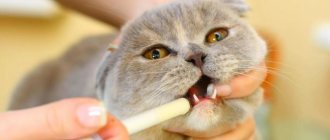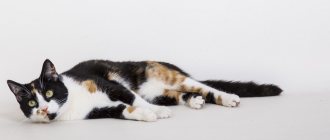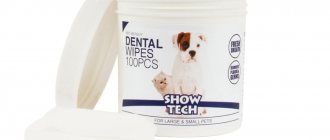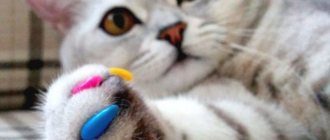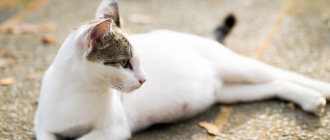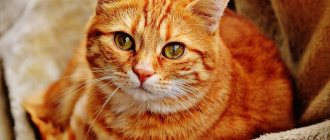In general, when the room temperature is below or equal to 25 degrees, cats feel completely comfortable. Try to ventilate the room as often as possible and, if possible, leave the windows open.
The biggest misconception is that grooming your cat will help it in hot weather.
Alas, this is not true. On the contrary: a cat can get heatstroke because there is a heat chamber under the animal's fur that helps maintain normal body temperature.
Some resort to this method because the pet begins to shed heavily in the heat. But, in fact, this is a normal phenomenon - in this way the animal protects itself from the summer weather and the best way out in this situation is to simply comb it more often.
If shedding lasts more than 30 days, it is recommended to consult a specialist.
You should also contact a veterinarian when the cat opens its mouth and breathes with its mouth open (like a dog). This could be a sign of heat stroke. First of all, wrap your pet in a wet towel (this will give him first aid), and then be sure to visit a veterinary clinic, especially if his body temperature is above 39.5 degrees.
How to tell if your cat is overheated
If “overboard” is 30+, and the apartment is stuffy, watch your pet. There are signs that show that he cannot do without your help:
- breathes quickly, sticking out his tongue like a dog;
- does not drink for more than 6 hours in a row;
- lies in one position;
- does not respond to calls and external stimuli;
- trembles;
- pupils dilated;
- the heart beats faster than usual;
- nose is dry and hot.
Have you noticed at least a few symptoms from the list? Start providing first aid.
The cat is alone in the apartment
If the owners are forced to leave their pet alone for the whole day in a stuffy apartment, they are obliged to provide the cat with comfortable conditions in which the animal can more easily tolerate the heat:
- give the animal access to the bathroom;
- provide the cat with a sufficient amount of drinking water (put out not one bowl, but several);
- ventilate the apartment;
- leave a damp towel on the cat bed;
- hang wet sheets and towels in the apartment.
But if the room is too stuffy, the method of humidifying the air with wet towels will not work, since humid and hot air can negatively affect the functioning of the animal’s cardiovascular system.
Attention! The cat himself is able to find the most comfortable and coolest place in the apartment.
If he finds one and is escaping the heat there, do not drive the animal away, even if its presence causes you inconvenience.
When leaving your cat alone, provide him with enough drinking water.
Quench your thirst
Basically, cats are afraid of water and don’t even drink it often - this is their physiology. And in the heat they follow their ingrained habit and simply forget to drink. Your task is to make the fluffy drink at least a sip. To do this we can:
- bring a bowl of water to the animal, wet its face and lips and thus force it to drink;
- Fill a syringe without a needle with cool water and pour 5-10 cubes into the cat’s mouth.
Both ways are good. If the cat is healthy, he will quickly return to normal. The main thing for us is to prevent dehydration. All zoos around the world are well aware of this, and in the summer heat they give predators ice with added blood.
Well, domestic cats will happily accept nutritious ice from light broth or milk.
Advice
If your cat is sweltering from the heat but flatly refuses water, give her a couple of ice cubes with 1 drop of catnip or valerian extract.
Animal behavior is an indicator of temperature conditions
In cats, behavior does not clearly illustrate heat exhaustion. The reason for this is the distribution of receptors responsible for the perception of heat or cold in the animal’s body. Confirmation that cats also get hot is their more imposing behavior in the summer and lack of mobility. A characteristic position indicating that the cat is hot and is trying to cool itself down on its own is lying on its back. It is on the stomach that the largest number of thermal receptors are located, which the cat naturally cools during the heat. Playfulness appears in a cat if it gets rid of excess fluff, which prevents heat transfer to the environment. Grooming a cat is currently in great demand, because in addition to the aesthetic side, it also radically solves the problem of overheating of a pet. Some cats, following the tradition of fear of water, do not hesitate to lie in a cold, dry bath or sink to cool down. In the summer, less and less can you find a cat sleeping on the sofa (it’s hot), and more and more on the floor. Frequent changes in body position are additional evidence that the animal is hot. Moreover, an elongated pose indicates heat is being transferred outward, while a cat squeezed into a ball is trying to retain heat within itself. Observation of the habits of cats allows us to conclude that their diet undergoes a number of changes in the summer. Meat and dry food are in less demand, and greater preference is given to drink and fish.
Lowering body temperature
Our best allies are water and coolness.
- Close the curtains, open the windows, or move the cat to a cooler room.
- Saturate the sponge with cold water. Wet the cat's paw pads, head and neck. You can also have a belly if you are allowed. Repeat the procedure at least once an hour.
- Cover the sufferer with a wet waffle towel. Just don’t forget to wet it every 5 minutes, otherwise the animal will receive a hot compress instead of a cooling procedure.
- Freeze water in a plastic bottle and place it next to the cat, wrapped in a cloth. This will humidify and cool the air around you.
- Direct the fan at your pet in a gentle mode. Let a light breeze blow over it.
You can combine business with pleasure. I made a “house” for my cat from two stools covered with a wet sheet, and placed a fan nearby. He adored his shelter, and only in the evening, sleepy and fresh, did he go out for dinner.
Hot danger
In hot weather, never leave your dog in the car, even if you are leaving for a short time! The air in the car heats up instantly, and the animal simply cannot breathe. The animal will overheat in a matter of minutes.
A closed, thick bag or a synthetic carrier can become the same “stove” for a miniature dog (Learn more about how to choose carrier bags for dogs). Therefore, if you urgently need to transport an animal, it is better to take it on a leash - and in your arms.
Be carefull!
Even if you conscientiously follow all the rules to save your pet from the heat, still monitor the dog’s condition.
The first signs of heatstroke in a dog: lethargy, vomiting, loss of consciousness, disorientation in space, unsteady gait, increased body temperature, glassy eyes.
If it does get hit...
If your pet is overheated, you need to contact a veterinarian, but you will have to provide first aid to the animal before going to the hospital.
At the first symptoms of heat or sunstroke, take the animal to a cool place and provide it with access to fresh air: open a window or turn on a fan or air conditioner.
We feed correctly
On hot days, your cat may refuse to eat. There is no need to force feed her. The owners’ task is to make her life easier and support her strength. In some cases, it even makes sense to move away from your usual diet. Especially if the animal is on dry food.
For variety, offer your animal lighter meals:
- chilled fermented milk products;
- ground raw turkey;
- minced boiled turkey or chicken with the addition of water or stewed vegetables (zucchini, carrots);
- chilled or frozen poultry broth;
- 1 tablespoon of low-fat and not very sweet ice cream for dessert.
Most often, cats decide for themselves what is best for them to eat on a hot day. And their desires are paradoxical. For example, my Norwegian Forest Cat loved cucumbers and melon. The main thing was to think of treating him with plant delicacies.
Read more about proper nutrition in the article What to feed your cat.
Fresh air
In hot conditions, the body urgently needs fresh air: stale apartment air, containing insufficient oxygen, will have to be inhaled more often to supply the organs. And with rapid breathing, the load on the heart and lungs increases, which is undesirable in the heat.
Based on this, the first thing to do is open the windows for ventilation. Make sure that the animal does not jump out the window. To do this, special metal mesh is placed in the window frames. Not to be confused with mosquitoes, which break through easily.
Creating a microclimate at home
It's great if you live in your own house with a garden where there are secluded shady corners. Here is a cat walking on its own, and without you, it will figure out where it is better to hide. Your task is to place bowls of water throughout the area and pour fresh water daily.
In apartments the situation is different. There during the day it is sometimes hotter than outside and stuffy. Therefore, the owner, when leaving for work, and especially leaving for the weekend, must provide his pet with a comfortable existence. Here is a list of what you need:
- Air flow due to micro-ventilation.
- Thick curtains to protect the room from sunlight.
- Fresh water and food, for this there are automatic drinkers and feeders.
- Clean toilet.
Advice
Pet stores sell cooling gel mats for animals; they keep the temperature constant between 17-25 degrees. Experience shows that animals like them, and at the same time they save them from overheating.
Is the dog hot? Run away from the sun!
It is important to avoid walking during hot hours. Try to walk your dog in the morning and late afternoon when solar activity is not as high. If you can't calculate the time, walk in the shade. The higher the temperature, the less time you spend walking.
Living water
- Make sure your pet always has clean, cool water in his bowl or drinking bowl. Imagine what it’s like to be thirsty in the heat and not be able to quench it!
- Bathe your dog more often. If you live in a private house, then you can simply water a large dog with a hose.
- Place a damp sheet on the animal's bedding.
- Pour water into the bath and leave the door open - the animal may want to cool off on its own.
On a note
- Do not forget to ventilate the apartment, but do not create drafts so that your pet does not get blown out.
- Don't let your pet become overexerted. Less active games and intense training!
- Change the animal's diet. Eliminate heavy and fatty foods for a while.
- If your four-legged friend has become less mobile and is lying down more and more often, there is no need to immediately sound the alarm: in this way the dog helps itself to cool down.
What cat breeds do not tolerate heat well?
Persians, British and exotics - they have a flat, snub-nosed muzzle and modified upper respiratory tracts. This makes breathing difficult. And thick, poorly ventilated wool can lead to overheating. It is recommended to comb them daily or cut them for the summer.
Siberian and Norwegian forest dogs - they are better off galloping across snowy expanses. Their wool is waterproof and retains heat well.
Sphynx - hairless cats can get sunburned and even get sunstroke. Therefore, it is recommended to let them out for a walk before 12 noon and after 5 pm, applying sunscreen with a minimum factor of 20, and odorless. In the evening, the cream must be removed with special wipes to allow the skin to breathe.
So if you haven’t yet decided on a breed and haven’t got a pet, take into account the climate where you live. I hope the article What breed of cats to choose for an apartment will help you make the right decision.
Important tips and do's and don'ts
Cats should be healthy even in hot weather. Try not to harm them.
- Never lock your cat in the car, even for a few minutes.
- Do not lock yourself in an apartment unattended for more than 3 days.
- Avoid sleeping with the air conditioner on.
- Switch an overweight animal to a gentle diet with plenty of fluids.
- Do not feed frozen meat. Cats lick this ice slowly, and swallow the meat whole without chewing, which can cause digestive problems.
- If you transport your cat in a carrier, give it a bottle every hour.
- Don't swim while it's hot. Firstly, it's a lot of stress. Secondly, wet wool will stick to the body and heat up. And thirdly, while the cat gets itself in order, it will be exhausted.
- When you cannot help your pet on your own, contact your veterinarian immediately!
If you wish, watch video recommendations from other cat lovers.
Physiology of the cat family
A cat doesn’t have that many sweat and sebaceous glands to get rid of excess heat, so wetting its paws with cool water and monitoring the cat’s temperature using its dry, heated nose won’t hurt, in order to confirm the opinion that the pet is feeling normal.
The normal temperature of a cat is 38.2, which it maintains by all means available to it, although nature has somewhat spared this individual, providing it with a large number of receptors that are more sensitive to cold rather than heat. This is why a cat can walk completely calmly on hot objects, to the surprise of us humans.
But what to do if the cat is hot or overheated? You should not wet her fur with cool water, which will aggravate her condition and create a greenhouse effect. The best home remedy would be to immerse the entire animal (except for the head) in cool water and consult with a veterinarian as soon as possible about further steps to save the animal.
The cat is hot.
source:
https://www.cat-and-cat.com/index.php?name=Pages&op=page&pid=89
When a cat is hot, it opens its mouth, begins to breathe rapidly and sticks out its tongue. When overheated, a cat develops weakness, apathy, and coordination of movements is impaired. To reduce body temperature, the cat carefully licks its fur coat, after which its humidity increases, and body temperature drops for a while.
| For our beloved pets, with rare exceptions, wool helps them cope with the cold, but in hot weather such a fur coat creates additional problems. Heat stroke in a cat occurs when the body overheats, emphasizes Cat-and-cat.com. Sunstroke is damage to a cat's central nervous system caused by intense exposure to direct sunlight. With heat and sunstroke, the animal's body temperature rises, and if it is not normalized, your pet may die. The cat is hot. The main signs of heat and sunstroke: Impaired body coordination; Rapid breathing with an open mouth and protruding tongue; Pull back your lower eyelid. If there is no moisture between the eyelid and the eye, then the cat’s body is very dehydrated; If, with slight pressure on the gum, it turns pale and does not return to its previous pink color, then your pet’s condition is critical; If you take a lying cat by the withers and then slowly release it, and the fold of skin on the back does not straighten out immediately, then it is necessary to urgently take measures aimed at restoring the animal’s dehydrated body. What to do if you have heat or sunstroke? First, move your pet away from the heat source. Place the cat in the coolest place in the house. Give your cat a shower by placing it in the sink and directing a stream of cool water to the back of the animal's head. Give the cat water or saline solution (one pinch of salt per glass of water). If she refuses to move and drink, then use a syringe to inject her with 3-5 ml of liquid or give the animal something to drink from a spoon. Apply a damp cloth to the cat's head and legs (ice is not recommended). Give your cat five drops of Corvalol diluted with water. If the animal’s condition has not changed, then urgently show the cat to a veterinarian. Preventive measures that will prevent you from getting heatstroke or sunstroke: Make sure your cat is in the shade or in a well-ventilated area on a hot summer day. Make fresh drinking water available to your animal. When it's hot, never leave your pet in a carrier or car in direct sunlight. When leaving home, do not forget to turn off the heater. |
source: https://dogsecrets.ru/stati/606-sobaki-v-jarkuyu-pogodu.html
Dogs, like people, have a hard time withstanding heat. Therefore, the higher the temperature outside the window, the more vigilant owners of four-legged animals need to be.
Sensitivity to heat in pets depends not only on their age and health, but also on their breed, coat length, and nose shape. However, by following just a few simple rules, you can easily protect your “friend” from the merciless rays.
